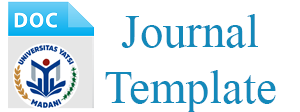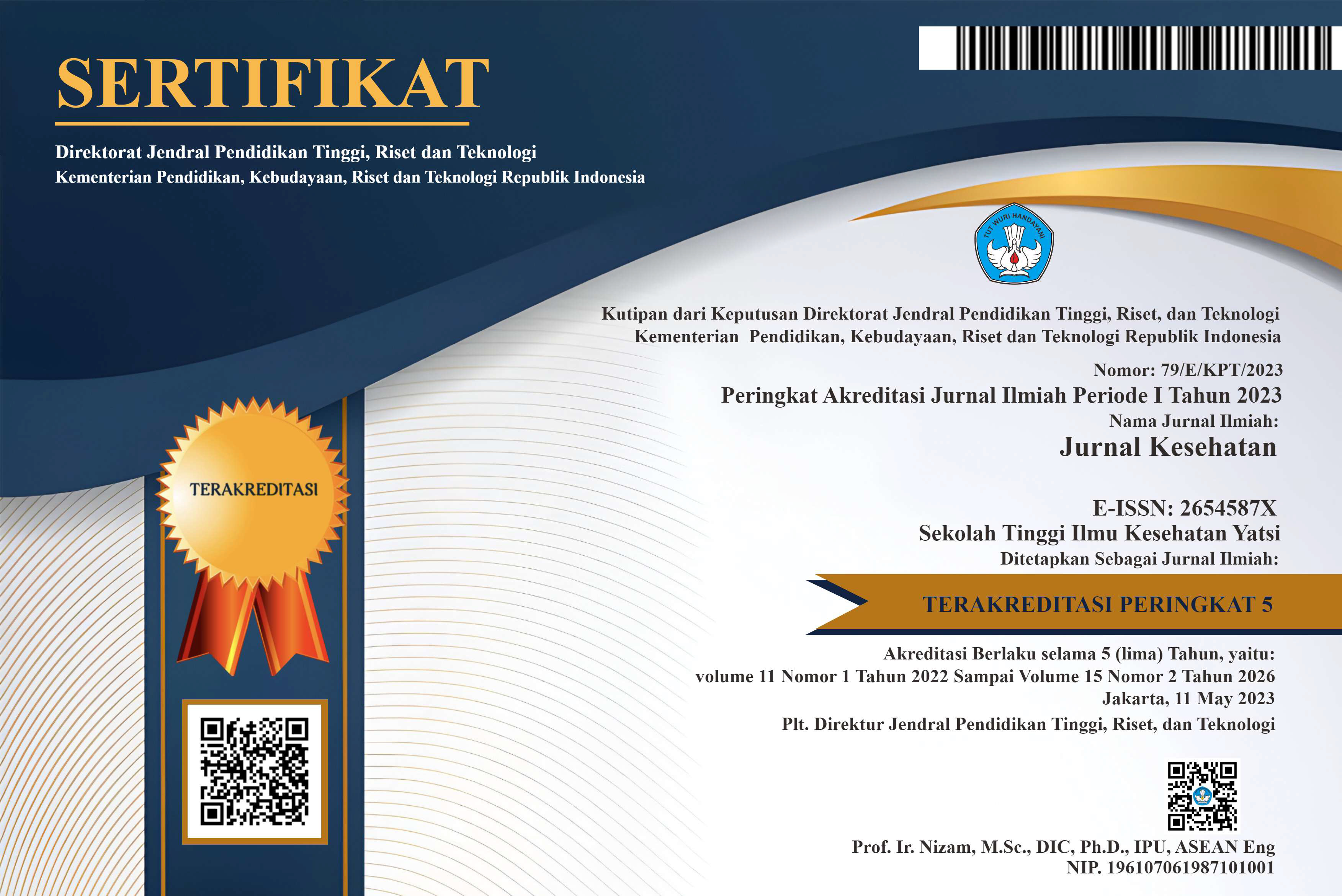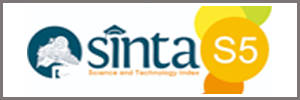Analisis Stunting Pada 1000 Hari Pertama Kehidupan Dalam Aspek Sosial Budaya : Systematic Review
Abstract
ABSTRAK
Latar Belakang : Periode emas dimulai sejak dalam kandungan ibu sampai usia anak dua tahun “seribu hari pertama kehidupan”, keadaan dimana tubuh anak tidak sesuai dengan standar usianya menjadi salah satu tanda buruknya tumbuh kembang anak yang berasal dari akumulatif faktor kesehatan yang buruk sebelum dan dua tahun setelah kelahiran. Prevalensi stunting Indonesia dalam lima tahun terakhir masih jauh dari target yang ditetapkan oleh organisasi kesehatan dunia, dan termasuk lima tertinggi kasusnya di dunia. Kerangka konseptual WHO perihal stunting menyatakan ada faktor sosial budaya sebagai salah satu faktor penyebabnya. Tujuan tinjauan sistematik ini untuk merangkum penelitian-penelitian sebelumnya yang memberikan gambaran umum terkait menggunakan aspek budaya terhadap insiden stunting pada 1000 HPK Metode : Penulisan menggunakan panduan PRISMA dengan menggunakan tiga sumber data yang berasal dari ScienceDirect, PubMed, dan Google Scholar menggunakan kata kunci “stunting”, “budaya”, ”1000 HPK”. Hasil : Tinjauan dari tujuh jurnal yang sudah dipilih mengemukakan budaya mempunyai dampak pada fase pencegahan stunting, jika dalam usia dua tahun menunjukkan tanda stunting maka diperlukan suplementasi tambahan lainnya. Kesimpulan : persepsi makan mempunyai nilai budaya serta sosial, pemanfaatan budaya pada status gizi di 1000 HPK akan lebih mudah diterima masyarakat sehingga mempunyai dampak terhadap pencegahan stunting.
Kata kunci: stunting, budaya, 1000 HPK
ABSTRACT
Background: The golden period starts from the mother's womb until the child is two years old "the first thousand days of life", a condition where the child's body does not match the aged standard is one of the signs of poor child development and development which comes from the accumulative factors of poor health before and after two years after birth. The prevalence of stunting in Indonesia in the last five years is still far from the target set by the world health organization and is among the five highest cases in the world. The WHO conceptual framework regarding stunting states that sociocultural factors are contributing factors. The purpose of this systematic review is to summarize previous studies which provide an overview regarding using cultural aspects of stunting incidents in 1000 HPK Methods: Writing uses the PRISMA guide using three data sources originating from ScienceDirect, PubMed, and Google Scholar using the keyword "stunting" ”, “culture”, ”1000 HPK”. Results: A review of the seven journals that have been selected suggests that culture has an impact on the stunting prevention phase, if at the age of two they show signs of stunting, another additional supplementation is needed. Conclusion: the perception of eating has cultural and social values, and the use of culture on nutritional status at 1000 HPK will be more easily accepted by the community so, it will have an impact on stunting prevention.
Keywords: stunting, culture, 1000 days of life
References
Bashir, S., Khan, N., Ariff, S., Ihtesham, Y., Tanimoune, M., & Rizvi, A. (2022). Effectiveness of nutritional supplementation during the fi rst 1000-days of life to reduce child undernutrition : A cluster randomized controlled trial in Pakistan. 4first. https://doi.org/10.1016/j.lansea.2022.100035
Bolton, J. L., Schulmann, A., Garcia-curran, M. M., Molet, J., Mortazavi, A., Baram, T. Z., Bolton, J. L., Schulmann, A., Garcia-curran, M. M., Regev, L., & Chen, Y. (2020). Article Unexpected Transcriptional Programs Contribute to Hippocampal Memory Deficits and Neuronal Stunting after Early-Life Adversity ll Unexpected Transcriptional Programs Contribute to Hippocampal Memory Deficits and Neuronal Stunting after Early-Life . CellReports, 33(11), 108511. https://doi.org/10.1016/j.celrep.2020.108511
Boyle, B., & Altimier, L. (2022). On family-centred and child-centred care - And the moral distress therein. Journal of Neonatal Nursing, 28(2), 81–82. https://doi.org/10.1016/j.jnn.2022.02.001
Edney, S. K., Basu, A., Harding, C., & Pennington, L. (2022). Short-term feeding outcomes after neonatal brain injury. Journal of Neonatal Nursing, 28(4), 265–269. https://doi.org/10.1016/j.jnn.2021.08.016
Elis, A., & Mustari, R. (2020). The Role of Presenting Exclusive Breastfeeding for The Prevention of Stunting Based on The Culture of Tudang Sipulung. Strada Jurnal Ilmiah Kesehatan, 9(2), 1230–1237. https://doi.org/10.30994/sjik.v9i2.461
Gelli, A., Margolies, A., Santacroce, M., Roschnik, N., Twalibu, A., Katundu, M., Moestue, H., Alderman, H., & Ruel, M. (2018). Using a Community-Based Early Childhood Development Center as a Platform to Promote Production and Consumption Diversity Increases Children’s Dietary Intake and Reduces Stunting in Malawi: A Cluster-Randomized Trial. Journal of Nutrition, 148(10), 1587–1597. https://doi.org/10.1093/jn/nxy148
Hadi, A. J., Riman, E. Y., Sudarman, S., Manggabarani, S., Ahmad, H., Ritonga, N., Antoni, A., & Ishak, S. (2022). Socio-Family Culture Against Stunting Risk : A Cross- Sectional Population-Based Study. 9(1), 1301–1311.
Hines, M., Hardy, N., Martens, A., & Zimmerman, E. (2022). Birth order effects on breastfeeding self-efficacy , parent report of problematic feeding and infant feeding abilities. Journal of Neonatal Nursing, 28(1), 16–20. https://doi.org/10.1016/j.jnn.2021.07.003
Ibrahim, I., Alam, S., Adha, A. S., Jayadi, Y. I., & Fadlan, M. (2021). Hubungan Sosial Budaya Dengan Kejadian Stunting Pada Balita Usia 24-59 Bulan Di Desa Bone-Bone Kecamatan Baraka Kabupaten Enrekang Tahun 2020. Public Health Nutrition Journal, 1(1), 16–26.
Indrio, F., Dargenio, V. N., Marchese, F., Giardino, I., & Vural, M. (2022). The Importance of Strengthening Mother and Child Health Services during the First 1000 Days of Life: The Foundation of Optimum Health, Growth and Development. The Journal of Pediatrics, 245, 254-256.e0. https://doi.org/10.1016/j.jpeds.2022.03.001
Kahale, L. A., Elkhoury, R., Mikati, I. El, Pardo-hernandez, H., Khamis, A. M., Schünemann, H. J., Haddaway, N. R., & Akl, E. A. (2021). RESEARCH ARTICLE PRISMA flow diagrams for living systematic reviews : a methodological survey and a proposal [ version 1 ; peer review : awaiting peer review ].
Kamran, F., Tajalli, S., Ebadi, A., Sagheb, S., & Fallahi, M. (2022). Quality of life and stress in mothers of preterm infant with feeding problems : A cross sectional study. Journal of Neonatal Nursing, October 2021. https://doi.org/10.1016/j.jnn.2022.02.006
Kementerian Kesehatan RI. (2019). Laporan Nasional Riskesdas 2018. Lembaga Penerbit Badan Penelitian dan Pengembangan Kesehatan (LPB).
Ken, M., Maye, L., & Hastie, C. (2022). Influence of grandmothers on breastfeeding practices in a rural community in Papua New Guinea : A critical discourse analysis of first-time mothers ’ perspectives. Women and Birth, December 2021, 1–7. https://doi.org/10.1016/j.wombi.2022.08.001
Lingam, S. S., Sawant, P. B., & Chadha, N. K. (2019). Duration of stunting impacts compensatory growth and carcass quality of farmed milkfish , Chanos chanos ( Forsskal , 1775 ) under field conditions. Scientific Reports, 1–11. https://doi.org/10.1038/s41598-019-53092-7
Mekonnen, H., Lakew, D., Tesfaye, D., & Wassie, B. (2020). Determinants of stunting among under-five years children in Ethiopia from the 2016 Ethiopia demographic and Health Survey : Application of ordinal logistic regression model using complex sampling designs. Clinical Epidemiology and Global Health, 8(2), 404–413. https://doi.org/10.1016/j.cegh.2019.09.011
Mulyaningsih, T., Mohanty, I., & Id, V. W. (2021). Beyond personal factors : Multilevel determinants of childhood stunting in Indonesia. PLOS ONE, 1–19. https://doi.org/10.1371/journal.pone.0260265
Natividad, G. (2019). Stunted firms : The long-term impacts of colonial taxation R. Journal of Financial Economics, 134(3), 525–548. https://doi.org/10.1016/j.jfineco.2019.05.003
Putriana, Armenia Eka ; Masfufah ; Kariani, N. K. (2020). BUGIS Stunting Based on Eating Culture of Makassar , Toraja and Bugis Tribes. J. Gizi Kerja Dan Produktivitas, 1(September), 25–33. https://doi.org/http://dx.doi.org/10.52742
Rahayu, A. dkk. (2018). STUDY GUIDE - STUNTING DAN UPAYA PENCEGAHANNYA (Hadianor (ed.); 1st ed.). CV Mine.
Razak, A., Mohd, Z., Nasir, M., Taib, M., Ying, W., & Tan, K. (2020). Early Human Development Early growth and home environment are associated with cognitive development in the fi rst year of life of Malaysian infants. 140(June 2019), 20–25. https://doi.org/10.1016/j.earlhumdev.2019.104890
Saleh, A., Syahrul, S., Hadju, V., Andriani, I., & Restika, I. (2021). Role of Maternal in Preventing Stunting : a Systematic Review. Gaceta Sanitaria, 35, S576–S582. https://doi.org/10.1016/j.gaceta.2021.10.087
Sari, Diah Retno; Fatmaningrum, Widati; suryawan, A. (2019). RELATIONS BETWEEN ETHNIC , EXCLUSIVE BREASTFEEDING , AND BIRTH WEIGHT WITH STUNTING IN. Indonesian Midwifery and Health Science Journal, 3(4), 320–330. https://doi.org/10.20473/imhsj.v3i4.2019.320-330
Sujata, S., Das, K., Mukhopadhyay, K., Kaur, S., & Rohilla, M. (2022). Effect of antenatal and postnatal individualized counseling of mothers on exclusive human milk feeding in preterm infants during hospital stay and at discharge : A randomized controlled trial. Journal of Neonatal Nursing, 28(1), 31–36. https://doi.org/10.1016/j.jnn.2021.03.003
Van Tuijl, C. J. W., Madjdian, D. S., Bras, H., & Chalise, B. (2020). Sociocultural and economic determinants of stunting and thinness among adolescent boys and girls in Nepal. Journal of Biosocial Science. https://doi.org/10.1017/S0021932020000358
Vishwakarma, D., Sharma, S. K., & Puri, P. (2021). Children and Youth Services Review Linkages between consanguineous marriages and childhood stunting : Evidence from a cross-sectional study in India. Children and Youth Services Review, 122(December 2020), 105922. https://doi.org/10.1016/j.childyouth.2021.105922
World Health Organization. (2010). Nutrition Landscape Information System (NLIS) Country Profile Indicators.










